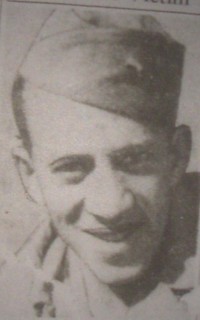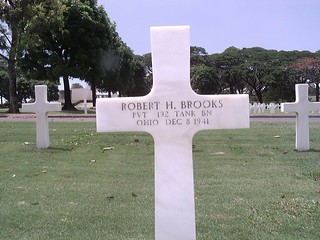Story by John Trowbridge, Kentucky National Guard
In recognition of February as Black History Month kentuckyguard.com is publishing several articles honoring African-American men and women who are significant figures in Kentucky’s military history. The following is one such story ….
[caption id="" align="aligncenter" width="576"]

Pvt. Robert H. Brooks is the namesake of Brooks Field at Fort Knox. Ky. When the news of his death reached Fort Knox, the post commander, General Jacob Devers, decided to name the main parade ground in Brooks’ honor.
FRANKFORT, Ky. -- Pvt. Robert H. Brooks the son of Adline and Ray Brooks, was born on October 8, 1915, in McFarland, Kentucky. He was raised in Sadieville, Kentucky. As an adult, he moved to Cincinnati, Ohio, where he was inducted into the army in late 1940.
While training at Fort Knox, Kentucky in November, 1940, Brooks was assigned to the maintenance section of D Company, 192nd Tank Battalion, a Kentucky National Guard unit which had been federalized.
[caption id="" align="alignleft" width="200"]

Pvt. Robert H. Brooks, the first U.S. Armored casualty of World War II.
In late August, 1941, the 192nd went on maneuvers in Louisiana. Due to the battalion’s outstanding performance during the maneuvers it was selected to be sent overseas. D Company traveled by train to San Francisco. From there, they boarded ships for the Philippines Islands.
On December 8, 1941, just ten hours after the attack on Pearl Harbor, Japanese planes appeared over Clark Field near Fort Stotsenburg, Philippine Islands. Most of the members of D Company were at lunch at the time of the attack. Brooks was with two mechanics from maintenance section when the first bombs began to fall. It is believed that Brooks was attempting to get to his half-track to man the .50 caliber machine gun, when a bomb exploded next to him. He was killed instantly.
When the news of his death reached Fort Knox, the post commander, General Jacob Devers, decided to name the main parade ground in Brooks’ honor. Brooks was officially declared the first U. S. Armored Forces casualty of WW II.
One of General Dever's subordinates called the Farmer's Deposit Bank in Sadieville, attempting to reach Robert's parents. As it turned out, the bank had the only phone in the town. W. T. Warring at the bank answered the phone. The aide asked if it would be possible for someone from the town to be present at the dedication ceremony.
The aide asked Mr. Warring if he could tell him anything about Robert's parents. Mr. Warring said,
" His parents are tenant farmers, ordinary black people; maybe you could contact them and see if they could come."
[caption id="" align="alignright" width="288"]

Following World War II Robert Brooks' remains were moved to the American Military Cemetery outside of Manila. He was posthumously promoted to private first class.
The general's representative hung up the phone and immediately called back. He said to Mr. Warring,
"Did you say they were black?" Warring responded,
"Yes, his mother and father are very dark."
The aide felt that this might change the situation. When he reported back to General Devers, the general said,
"It did not matter whether or not Robert was black, what mattered was that he had given his life for his country."
Remember, this was a time when the U.S. military was segregated. Blacks typically served in all-black units, such as the Tuskegee Airmen, 761st Tank Battalion and the lesser-known but equally distinguished 452nd Anti-Aircraft Artillery Battalion.
Being light-skinned, Brooks often passed for white. His fellow Soldiers knew his background, never questioned it as he was considered "just one of the guys."
The ceremony dedicating the main parade ground in honor of Robert Brooks was held with Robert's parents present. During the dedication, General Devers said in his dedication speech,
"In death there is no grade or rank. And in this greatest democracy the world has ever known, neither riches or poverty, neither creed or race, draws a line of demarcation in this hour of national crisis."
After the war, Robert Brooks' remains were moved to the American Military Cemetery outside of Manila. He was posthumously promoted to private first class.
Today a Kentucky Historical Marker located in Sadieville, Kentucky, honors Pvt. Robert H. Brooks’ service and sacrifice to our country.